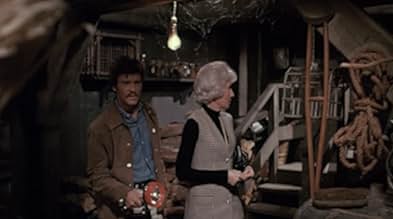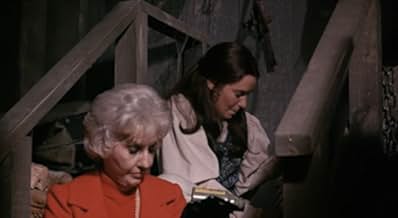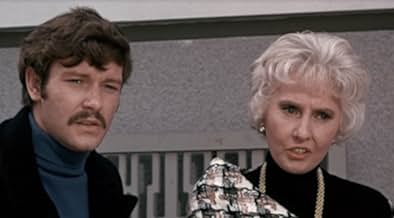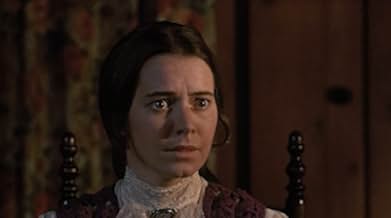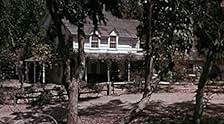IMDb-BEWERTUNG
5,6/10
1088
IHRE BEWERTUNG
Eine Frau und ihre Nichte ziehen in ein Stammhaus auf dem Land der Amish, das von zwei Geistern aus dem Unabhängigkeitskrieg heimgesucht wird.Eine Frau und ihre Nichte ziehen in ein Stammhaus auf dem Land der Amish, das von zwei Geistern aus dem Unabhängigkeitskrieg heimgesucht wird.Eine Frau und ihre Nichte ziehen in ein Stammhaus auf dem Land der Amish, das von zwei Geistern aus dem Unabhängigkeitskrieg heimgesucht wird.
Handlung
WUSSTEST DU SCHON:
- WissenswertesThe German poster features an image of Jessica Harper from Suspiria: In den Krallen des Bösen (1977).
- PatzerWhen Sarah comes in, and the others are already there, she has a break in character, and ultimately faints. She is wearing a short skirt and long socks when she comes in and faints. But when they move her to the couch, she is wearing trousers and no socks.
- VerbindungenFeatured in Elvira's Halloween Movie Schlock-A-Thon (1993)
Ausgewählte Rezension
The House That Would Not Die is a solid TV-film that could have been stronger had screenwriters stuck closer to Barbara Michael's excellent supernatural suspense novel, "Ammie, Come Home." Michael's story is set in Washington, D.C.; Ruth, a Department of Commerce official, has lived in a Georgetown row house for some years after inheriting it from a distant cousin. There is no ghostly presence until Ruth's niece Sara moves in with her to attend a nearby university. Sara first hears a voice in the night calling "Ammie, come home," but aunt & niece decide it's a neighbor calling a lost pet. When Ruth meets one of Sara's professors, the adventurous son of a famous Washington hostess (a character based on Marjorie Merriwether Post), the ghostly presences intensify & become violent. By using entries in the family Bible and searching old newspapers & archives, the 4 major characters (Ruth, the professor--who becomes her love interest--Sara & her boyfriend) piece together the tragic tale of the house's original builder & his daughter, Amanda. During the Revolution, Amanda's father was a royalist but Amanda fell in love with a young officer in the American army. When her father discovered they were about to elope, he killed them & buried the bodies in the basement of his house. He lived there as a recluse until he was killed when the house burned. Relatives (Ruth's ancestors) inherited the land & built a new house, never knowing what had happened. After young Sara moved in, the spirits of Amanda & her father began to re-enact their tragedy endlessly. It is the disembodied voice of Amanda's lover calling, "Ammie, come home."
Why the writers moved the film to Amish country in Pennsylvania is a mystery, unless they figured in 1970 Washington had enough problems & didn't need any more ghosts. Having Ruth occupy the house only as the film begins robs the novel's story line of a major point: that Ruth had lived there for some years with no sign of supernatural activity. The sudden appearance of a voice crying in the night is, in the novel, an unexpected, vaguely ominous occurrence,which Ruth & Sara assume is a neighbor. That there are neighbors in Georgetown highlights a second point in the novel that is weakened by the shift to Pennsylvania: a setting in highly civilized, urbane Georgetown makes supernatural events seem even more incongruous with everyday life than the film's rural setting in Pennsylvania, where the house's isolation, like Hill House in "The Haunting," seems to invite every ghost within shouting distance. (Why are these houses always 'way out in the country?)
Despite inferior adaptation from the novel, performances & production values in The House That Would Not Die are exceptional in every way. Stanwyck & Egan are physically perfect for the characters described in "Ammie, Come Home." As the at-times-possessed Sara, Wynn must portray not only that modern young woman but the long-dead Amanda too, and she does a very solid job. Her boyfriend is portrayed by Michael Anderson Jr., who does not resemble the tall, slim, dark character in Michael's novel, but plays the role well. All things considered, this is a worthwhile TV-film that will repay a viewing. But don't deny yourself the chance to read the book.
Why the writers moved the film to Amish country in Pennsylvania is a mystery, unless they figured in 1970 Washington had enough problems & didn't need any more ghosts. Having Ruth occupy the house only as the film begins robs the novel's story line of a major point: that Ruth had lived there for some years with no sign of supernatural activity. The sudden appearance of a voice crying in the night is, in the novel, an unexpected, vaguely ominous occurrence,which Ruth & Sara assume is a neighbor. That there are neighbors in Georgetown highlights a second point in the novel that is weakened by the shift to Pennsylvania: a setting in highly civilized, urbane Georgetown makes supernatural events seem even more incongruous with everyday life than the film's rural setting in Pennsylvania, where the house's isolation, like Hill House in "The Haunting," seems to invite every ghost within shouting distance. (Why are these houses always 'way out in the country?)
Despite inferior adaptation from the novel, performances & production values in The House That Would Not Die are exceptional in every way. Stanwyck & Egan are physically perfect for the characters described in "Ammie, Come Home." As the at-times-possessed Sara, Wynn must portray not only that modern young woman but the long-dead Amanda too, and she does a very solid job. Her boyfriend is portrayed by Michael Anderson Jr., who does not resemble the tall, slim, dark character in Michael's novel, but plays the role well. All things considered, this is a worthwhile TV-film that will repay a viewing. But don't deny yourself the chance to read the book.
Top-Auswahl
Melde dich zum Bewerten an und greife auf die Watchlist für personalisierte Empfehlungen zu.
Details
- Erscheinungsdatum
- Herkunftsland
- Sprache
- Auch bekannt als
- The House That Would Not Die
- Drehorte
- Produktionsfirma
- Weitere beteiligte Unternehmen bei IMDbPro anzeigen
Zu dieser Seite beitragen
Bearbeitung vorschlagen oder fehlenden Inhalt hinzufügen

Oberste Lücke
By what name was Das Geisterhaus (1970) officially released in Canada in English?
Antwort
